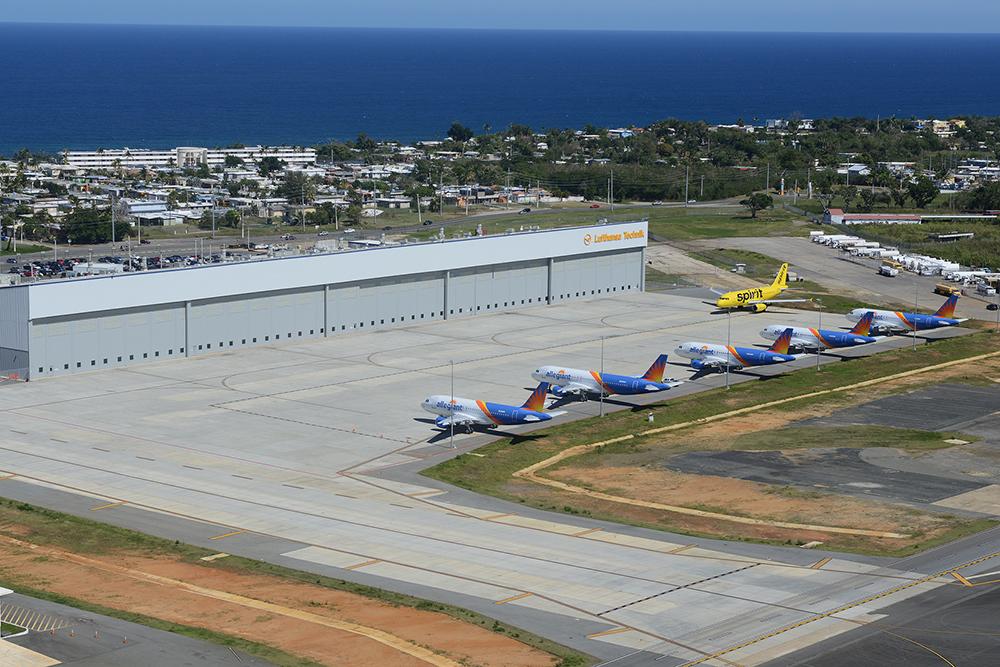
If, as is frequently said, Miami is the northernmost capital of Latin America, Rafael Hernández Airport in Aguadilla, Puerto Rico is the southernmost aerospace hub of North America. Lufthansa Technik (LHT) Puerto Rico is at the airport, and Honeywell, Pratt & Whitney and Lockheed Martin have facilities nearby. According to LHT, Puerto Rico’s location, workforce pipeline and economics uniquely position it to be a pillar for the company’s growth in the Americas region.
LHT Puerto Rico CEO Patrick Foley says the location offers very economic labor rates, excellent turn-times and high-quality work on the Airbus A320 family to both North and South American airlines.
With COVID-19 mostly behind, the shop has “as much business as we can manage now,” Foley says. Its five production lines are fully booked for 2022. Starting off with two customers in 2015, LHT Puerto Rico now has ten customers, from both North and South America. It is in discussions with possible new customers for both short- and long-term work.
Moreover, “it’s no secret that Lufthansa Technik wants to grow in the Americas, and this was the first step.” Foley says. He expects LHT will want to add more capacity over the next five years in the region, which might be in Puerto Rico, elsewhere in the Americas or a combination of both.
LHT chose Puerto Rico for its first Americas venture for several reasons. The location was strategic, midway between both North and South America. As Puerto Rico is a U.S. territory, obtaining FAA approvals was simpler. And one of the two launch customers, JetBlue Airways, suggested the Caribbean island.
In addition, the Puerto Rican government was very supportive, Foley notes. For example, the Aeronautical & Aerospace Institute of Puerto Rico (AAIPR) was established to train mechanics at about the time LHT opened its facilities. Furthermore, the University of Puerto Rico produces engineers that often go to work for NASA. “There’s a very talented pool of well-educated people here, fluent in both Spanish and English,” says Foley.
LHT Puerto Rico can source its mechanics from AAIPR or two other technical schools on the island: Puerto Rico Aviation Maintenance Institute and Caribbean Aviation Training Institute. It also draws workers from other stations in LHT’s global network, such as Malta, Sofia and the Philippines. The MRO can often attract Puerto Ricans who have gone to the mainland U.S., worked in maintenance shops there and want to return home.
Overall, LHT Puerto Rico typically recruits 15-20 trainee mechanics every six months for its more than 300-employee staff. Though Foley came to LHT Puerto Rico from LHT Shannon in Ireland, he says the majority of its managers are from Puerto Rico.
Due to the gap in living cost between Puerto Rico and the U.S. mainland, LHT can offer what Foley says are competitive labor charges that are highly attractive to North American customers. Puerto Rico mechanic wages are about 20% below the U.S. average.
Foley says customers also benefit from LHT’s “history, knowledge and access to information and solutions,” which he says are massive advantages. Currently, most technology innovation in LHT Puerto Rico is focused on digital solutions and going more online. “We are working hard to remove paper job cards” as part of LHT’s global roll-out of paperless initiatives, he says.
The LHT Puerto Rico shop only has room for narrowbodies and has only worked on A320-family aircraft so far. Adding capability for Boeing narrowbodies would mean adding tools, equipment, training and complexity. Still, Foley says it may only be “a matter of time” before the facility seeks Boeing work.
In any case, LHT Puerto Rico is eager to join the MRO recovery. Foley says it only took four days to be up and running after a Hurricane Maria in 2017, and LHT Puerto Rico has its own power and communications just in case one of these extraordinary storms strikes again. He adds that LHT Puerto Rico can adjust very fast to new conditions.





